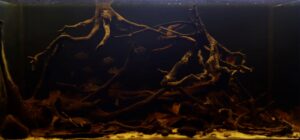Igapó-Reserva Nacional Allpahuayo Mishana Loretu, Peru
_st place in Biotope Aquarium Design Contest 2022

Volume of aquarium: 128L
Dimensions of aquarium: 80x40x40
List of fishes: 15x Hemigrammus Pulcher ,
6x Crenuchus Spilurus ,
List of plants: No plants
Description of Decorations and Substrate: The aquarium intends to simulate the natural environment where the fish naturally live, with larger wood at the bottom, in order to create safety zones for the species, with small suspended branches and several branches falling into the water. With this configuration it is possible to obtain free swimming zones, so that the fish can freely develop. At the bottom we have sand as found in the natural habitat, with the traditional white colors, as well as leaves and micro particles resulting from the decomposition of the leaves.
Description of Equipment: Filter: Marina Cf20 661L/H ,
Lighting Led Floodlight 10w and led tube 26w ,
Aquarium heater Interpet Thermasure 200w.
Water Parameters: Temperature 26º
PH 6.2
GH 3
KG 4
Additional Info: 30% month water change,
temperature controller STC1000.
Aquarium video:
https://wetransfer.com/downloads/4891245e50b09f74d70b1a27d97db67320220127235006/7db7d4?fbclid=IwAR3lT7NhLkqKZkY-evsHPBAjARB-qCLBeHRp8EBUAOnWMgV3gMoaNbu6GiY
Description of the Area Surrounding the Biotope: The Nanay River is a river in northern Peru. It is a tributary of the Amazon River, merging into this river at the city of Iquitos. The lower part of the Nanay flows to the north and west of the city, while the other part of the Nanay River flows through the Allpahuayo-Mishana National Reserve. Allpahuayo-Mishana National Reserve spans an area of 58,069.9 hectares and is located in the province of Maynas, region of Loreto, 23 km southwest of the city of Iquitos.[1]The area presents a varied forest topography going from seasonally flooded terrain to well-drained hills. Soils are also diverse, ranging from clay to almost pure white sand.[2] The Nanay river contributes to the flooding dynamic in the area, with a peak level in May, and a lowest level in September with 6 meters of difference.[1] It is in these areas of flooded forest that the biotope that I intend to represent emerges.
Description of the Underwater Landscape of the Biotope: At the height of heavy rains, when the Nanay River overflows into the reserve, it carries branches, small trees and leaves, creating an underwater contrast between the light colors of the white sands and the black waters, created by the tannins of the biomass deposited by the river, creating so a unique effect. The colors that best describe the biotopes are the browns of the roots and branches, the dark greens of the decaying leaves, the black colors of the water and the contrasting white of the unique sands of the Allpahuayo-Mishana Reserve.
Description of the Habitat Parameters: he reserve has a tropical climate, with relative humidity between 80-100%, with average water temperatures of 26ºC. The PH varies between values from 4.2 to 6.8, depending on the time of year, and for the dry seasons, the PH is lower [3].
List of Fishes and Invertebrates Occurring in the Nature Biotope: Apistogramma Allpahuayo , Satanoperca jurupari, Leporinus fridereci, Leporinus moralesi, Ancistrus sp, Auchenipterichthys sp, Crenicichla cincta, Eigenmannia virescens, Heros efasciatus, Hemigrammus pulcher, Hemigrammus ocellifer, Moenkhausia comma, Moenkhausia agnesae, Briconops melanurus, Aequidens tetramerus, Apistogramma athualpa, Crenuchus spilurus, Pyrrhulina laeta,
List of Plants Found in the Nature Biotope: Macaya fluviatilis,
Tonina fluviatilis,
Fissidens sp
Threats to the Ecology of the Biotope: Due to the unique characteristics of the sands present in the area, this was the target of several explorations that jeopardized the sustainability of the area. This reserve was created in 2004 with the aim of protecting and conserving its great biodiversity, especially its unique species of flora and fauna, as well as its white sands [4]. Aquarium dedicated to the Allpahuayo-Mishana Reserve, with the aim of making known the species present in the biotope, contributing to the warning of the danger of extinction of existing species. This is an area with great biodiversity, with unique characteristics that must be preserved.
Sources of Information:
[1] https://www.sernanp.gob.pe/allpahuayo-mishana ,
[2] García-Villacorta, Roosevelt; Ahuite-Reátegui, Manuel; Olortegui-Zumaeta, Mauro (2003). “CLASIFICACIÓN DE BOSQUES SOBRE
ARENA BLANCA DE LA ZONA RESERVADA ALLPAHUAYO-MISHANA”. Folia Amazónica (in Spanish). 14 (1): 17–33. doi:10.24841/fa.v14i1.151. ISSN 2410-1184,~
(3)https://acrobat.adobe.com/link/review?uri=urn%3Aaaid%3Ascds%3AUS%3A8443f3ae-0449-4a75-89f2-e2c9bd2da672&fbclid=IwAR2GSTpGD0LgVeIHOzh_dlSYFeANCF8Oi1-USN6eoUBMZ4Uu9Pm3TMPoCCo#pageNum=16 ,
(4)https://www.gob.pe/institucion/sernanp/informes-publicaciones/1718815-reserva-nacional-allpahuayo-mishana ,
(images) :
https://m.facebook.com/story.php?story_fbid=1359416097543507&id=479585218859937 ,
https://m.facebook.com/story.php?story_fbid=1373634519454998&id=479585218859937 ,
https://m.facebook.com/story.php?story_fbid=1375310052620778&id=479585218859937 ,
https://m.facebook.com/story.php?story_fbid=1382119088606541&id=479585218859937 ,
https://m.facebook.com/story.php?story_fbid=1406623646156085&id=479585218859937 ,
https://m.facebook.com/story.php?story_fbid=1407248682760248&id=479585218859937 ,
https://m.facebook.com/story.php?story_fbid=1412665155551934&id=479585218859937 ,
